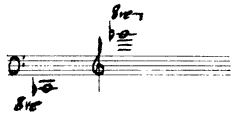rhoadley.net music research software blogs
aru seminars m&t critski focm1a cmc circuit bending mic2b sensor technology comp 3 sonic art major project
youtube vimeo facebook
Composing and Improvising
AF115003S
Instrumentation
piano
strings
woodwind
brass
percussion
guitar
harp
part-writing and transposition
Harp
For good examples of harp writing listen to the following pieces:
- Canticum Sacrum - Igor Stravinsky
- This..
- And so on...
Range

Operation
The pitch of the strings of the harp is governed by seven pedals, situated around the base of the instrument. Each pedal affects one note of the fundamental scale of the harp.
Without the use of any pedals, the harp's strings are tuned to the scale of C flat major:

Each pedal has two notches, which are achieved by depressing the pedal one or two degrees. Each notch raises the pitch of its particular string by one semitone, so, for instance, the C flat string may be sharpened one semitone by depressing the C pedal by one notch. This affects every C string throughout the range of the harp. So, the above operation would have the following overall effect:

Depressing the same pedal one further notch would have the following effect:

In the same way each and every string of the harp can be raised by one or two semitones, always bearing in mind that the pedal effects every string of the same note name. Except enharmonically, it is impossible for the harp to play the following:
![]()
However, it can be played:
![]()
using enharmonic changes.
A chromatic scale shows which notes can be played and how. C/1 represents the C string played with its pedal on the first notch, thus sounding a C natural. E/o represents the E string played 'open', that is with no pedal, so sounding an E flat...

Chords
Chords may be played within the limits defined by hand stretching and the total number of fingers! They are played more or less simultaneously, again depending on the ease with which the chord can be managed by the fingers. If a chord is required to be sounded as a single unit, the term non arp. should be used, that is, not arpeggiated. If arpeggiation is required, the symbol
![]()
should be used.
Glissandi
Any number of glissandi can be performed: most scales, (obviously excepting the chromatic), and a number of broken chords, although all of the above should be checked against the capabilities of the harp before being written.
While some dominant seventh chords are possible to play as glissandi:

others are not:

Obviously, the chord of the dominant seventh on C can be played, but an equivalent glissando cannot.
Notation
In some music, particularly fairly diatonic varieties, the harpist may be left to work out his or her own pedalling, but it is useful both to player and composer/arranger if difficult passages are notated with pedal markings included. This is done by simply writing in the part the new tuning of whichever string(s) are to be changed:

Remember the harp needs a little time to retune each string, and the latter cannot be changed while the string in question is resonating without the sound being affected.